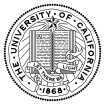University of California
| File:UC seal.png | |
| Motto | Fiat Lux (Latin, "Let there be light.") |
|---|---|
| Type | Public university system |
| Established | 1868 |
| Endowment | $7.28 billion[1] |
| President | Robert C. Dynes |
Academic staff | 13,335 |
| Undergraduates | 159,000 |
| Location | , , |
| Campus | 11 campuses (9 with undergraduate and graduate schools, 1 professional/graduate only, 1 affiliated law school), 2 national laboratories |
| Colors | Blue & Gold |
| Website | universityofcalifornia.edu |
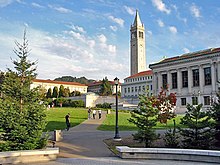
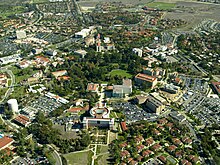


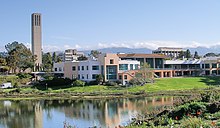
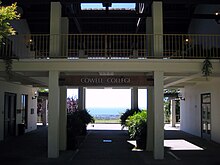
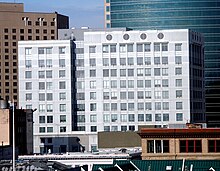
The University of California (UC) is a public university system in the state of California. Under the California Master Plan for Higher Education, the University of California is a part of the state's three-tier public higher education system, which also includes the California State University system and the California Community Colleges system.
The University of California has a combined student body of more than 191,000 students, over 1,340,000 living alumni, and a combined systemwide and campus endowment of just over $7.3 billion (8th largest in the United States).[2] Its first campus, UC Berkeley, was founded in 1868, while its tenth and newest campus, UC Merced, opened in the fall of 2005. All campuses enroll both undergraduate and graduate students, with two exceptions: the University of California, San Francisco campus enrolls only graduate and professional students in the medical and health sciences, and the independently administered Hastings College of the Law (also located in San Francisco) enrolls only graduate students. Six of its undergraduate campuses are ranked among the top 50 universities by both the U.S. News and World Report and the Academic Ranking of World Universities.
The University of California's campuses boast large numbers of distinguished faculty in almost every field. The University is considered a model for public institutions across the United States, although as of the 2005-06 fiscal year, only 29% of its total budget comes from the State.[3]
History
In 1849, the state of California ratified its first constitution, which contained the express objective of creating a complete educational system including a state university. Taking advantage of the Morrill Land Grant Act, the California Legislature established an Agricultural, Mining, and Mechanical Arts College in 1866. Although this institution was provided with sufficient funds, it lacked land.
Meanwhile, Congregational minister Henry Durant, an alumnus of Yale, had established the private Contra Costa Academy, on June 20, 1853 in Oakland, California. The initial site was bounded by Twelfth and Fourteenth Streets and Harrison and Franklin Streets in downtown Oakland. In turn, the Trustees of the Contra Costa Academy were granted a charter on April 13, 1855 for a College of California. State Historical Plaque No. 45 marks the site of the College of California at the northeast corner of Thirteenth and Franklin Streets in Oakland. Hoping both to expand and raise funds, the College of California's trustees formed the College Homestead Association and purchased 160 acres (650,000 m²) of land in what is now Berkeley in 1866. But sales of new homesteads fell short.
Governor Frederick Low favored the establishment of a state university based upon the University of Michigan plan, and thus in one sense may be regarded as the founder of the University of California. In 1867, he suggested a merger of the existing College of California with the proposed state university. The College's trustees agreed to merge with the state college to their mutual advantage, but under one condition — that there not be simply a "Agricultural, Mining, and Mechanical Arts College," but "a complete university." Accordingly, the Organic Act, establishing the University of California, was signed into law by Governor Henry H. Haight (Low's successor) on March 23, 1868.
The University of California's second president, Daniel Coit Gilman, opened the Berkeley campus in September 1873. Earlier that year, Toland Medical College in San Francisco had agreed to become the University's "Medical Department"; it later evolved into UCSF. In 1878, the University established its first law school in San Francisco with a $100,000 gift from Serranus Clinton Hastings; it is now Hastings College of the Law.
In 1908, a "University Farm" for the College of Agriculture was established at Davis, which became UC Davis in 1959. In 1919, the Legislature arranged for an existing normal school in Los Angeles to become the University's "Southern Branch." In turn, the Southern Branch became UCLA in 1927. In 1944, the former Santa Barbara State College--renamed UC Santa Barbara--became the third general-education campus of the University of California system.
The Riverside campus was founded as the Citrus Experiment Station in 1907 and was elevated to campus status in 1954. The San Diego campus was founded as a marine station in 1912 and became UCSD in 1959. Campuses were established at Santa Cruz and Irvine in 1965. UC Merced opened in fall 2005.
The California Master Plan for Higher Education of 1960 established that the top 12.5% (1/8th) of graduating high school seniors in California would be guaranteed a place in one of the UC campuses that offered undergraduate programs. Prior to the promulgation of the Master Plan, the top 15% of each graduating class was accepted.
Academics
UC researchers and faculty are responsible for 5,505 inventions and 2,497 patents. UC researchers create 3 new inventions per day.[4] At 32 million items, the University of California library system contains the third largest collection in the world, after the Library of Congress and the British Library.[citation needed]
Collectively, the system counts among its faculty (as of 2002):
- 389 members of the Academy of Arts and Sciences
- 5 Fields Medal recipients
- 19 Fulbright Scholars
- 25 MacArthur Fellows
- 254 members of the National Academy of Sciences
- 91 members of the National Academy of Engineering
- 13 National Medal of Science Laureates
- 32 Nobel laureates. Nobel laureates are present at all campuses except Davis, Merced, Riverside, and Santa Cruz.
- 106 members of the Institute of Medicine
AAU and AASCU
The University of California and most of its campuses are members of the Association of American Universities (AAU), while the California State University and several of its campuses are members of the American Association of State Colleges and Universities (AASCU).
Governance
The University of California is governed by the Regents of the University of California, as required by the current Constitution of the State of California. Eighteen regents are appointed by the governor for 12-year terms. One member is a student appointed for a one-year term. There are also 7 ex officio members — the Governor, Lieutenant Governor, Speaker of the Assembly, Superintendent of Public Instruction, president and vice president of the Alumni Associations of UC, and the UC President.
The Academic Senate, made up of faculty members, is empowered by the Regents to set academic policies. In addition, the systemwide faculty chair and vice-chair sit on the Board of Regents as non-voting members.
Originally the President ran only the first campus, Berkeley. Now, the Regents appoint a president to run the entire system. The UC Office of the President is located in downtown Oakland and effectively serves as the system headquarters. Individual campuses are managed by Chancellors, who are given a great degree of autonomy.
List of UC Presidents
| UC President | Years as President | |
|---|---|---|
| John LeConte | (1868–1870, acting) | |
| 1 | Henry Durant | (1870–1872) |
| 2 | Daniel Coit Gilman | (1872–1875) |
| 3 | W.T. Reid | (1881–1885) |
| 4 | Edward S. Holden | (1885–1888) |
| 5 | Horace Davis | (1888–1890) |
| 6 | Martin Kellogg | (1890–1893, acting) (1893–1899) |
| 7 | Benjamin Ide Wheeler | (1899–1919) |
| 8 | David Prescott Barrows | (1919–1923) |
| 9 | William Wallace Campbell | (1923–1930) |
| 10 | Robert Gordon Sproul | (1930–1958) |
| 11 | Clark Kerr | (1958–1967) |
| Harry R. Wellman | (1967, acting) | |
| 12 | Charles J. Hitch | (1968–1975) |
| 13 | David S. Saxon | (1975–1983) |
| 14 | David P. Gardner | (1983–1992) |
| 15 | Jack W. Peltason | (1992–1995) |
| 16 | Richard C. Atkinson | (1995–2003) |
| 17 | Robert C. Dynes | (2003–present) |
On August 13, 2007, President Dynes announced that he will step down effective June 2008, or until his replacement is selected. However, he also announced that Provost Wyatt (Rory) Hume will take over as the system's chief operating officer, effective immediately.
Campuses
At present, the UC system officially describes itself as a "ten campus" system consisting of the campuses listed below.[5] Only campuses under the direct control of the Regents and President are included in the official count. Although affiliated with the UC system, the Hastings College of Law is not controlled by the Regents or President, and must seek funding directly from the Legislature. However, under state law, the Juris Doctor from Hastings is awarded in the name of the Regents and bears the signature of the President.[6]
| Campus | Campus Land Area[7]
(acres) |
Founded | Enrollment[8]
(Fall 2006) |
Operating Expenses[9]
(2006) |
Athletics Nickname | U.S. News Ranking (2008)[10] | SJTU World Ranking[11](2006) | NCAA Category |
|---|---|---|---|---|---|---|---|---|
| UC Berkeley | 6,767 | 1868 | 33,558 | 1,589,122,000 | Golden Bears | 21 | 4 | Div I Pac-10 |
| UC Davis | 7,098 | 1905 | 29,637 | 2,267,719,000 | Aggies | 42 | 42 | Div I Big West |
| UC Irvine | 1,521 | 1965 | 25,024 | 1,421,290,000 | Anteaters | 44 | 44 | Div I Big West |
| UC Los Angeles | 419 | 1919 | 37,221 | 3,387,573,000 | Bruins | 25 | 14 | Div I Pac-10 |
| UC Merced | 7,045 | 2005 | 878 | 67,387,000 | Bobcats | unranked | unranked | NA |
| UC Riverside | 1,911 | 1954 | 16,622 | 459,885,000 | Highlanders | 96 | 102-150 | Div I Big West |
| UC San Diego | 2,141 | 1959 | 25,938 | 2,084,925,000 | Tritons | 38 | 13 | Div II |
| UC San Francisco | 181 | 1873 | 4,174 | 2,481,626,000 | no athletics | unranked | 18 | NA |
| UC Santa Barbara | 989 | 1958 | 21,016 | 620,208,000 | Gauchos | 44 | 35 | Div I Big West |
| UC Santa Cruz | 6,088 | 1965 | 15,012 | 451,656,000 | Banana Slugs | 79 | 102-150 | Div III |
Administration
While the UC campuses are operated fairly efficiently, some—such as UC Berkeley—do have a reputation among their students and alumni for mediocre customer service.[12][13] The most common symptoms are the long lines which students often must stand in to get even the simplest administrative tasks accomplished, the long wait times before phone calls are answered, and the overcomplicated paperwork that is often required. In August 1990, UC Berkeley attempted to ease the tedium of standing in line by setting up televisions which showed comedians making jokes about standing in line.[14]
During the 1990s, some campuses (like UCLA) aggressively streamlined many internal procedures with Web applications. Others (like UC Berkeley) were slower to adapt — as of 2006, Berkeley students still enroll in classes via the aging Tele-BEARS system, which is a Web interface on top of an older touch-tone telephone system (this despite the fact that UC Berkeley is one of the universities prominent in the development of many Internet technologies).
Labor unions
Some UC employees are represented by labor unions. Unions in the UC system include:
- University Professional and Technical Employees (UPTE) - health care, technical and research workers
- Coalition of University Employees (CUE) - clericals
- University Council-American Federation of Teachers (UC-AFT) - faculty and librarians
- United Auto Workers (UAW) - Academic student employees
- American Federation of State, County and Municipal Employees (AFSCME) - service workers and patient care technical employees.
- California Nurses Association (CNA) - Nurses
- Society of Professionals, Scientists and Engineers [3] - UC Scientists and Engineers at Lawrence Livermore National Laboratory
Admissions
Each UC school handles admissions separately, but a student wishing to apply for undergraduate admission uses one application for all UCs. If it is not already in electronic form, the application is then scanned into a computer and distributed to the individual campus undergraduate admission offices. Graduate and professional school admissions are handled directly by each department or program to which one applies.
Prior to 1986, students who wished to apply to a UC for undergraduate study could only apply to one campus. If the student was rejected at that campus, but otherwise met the UC minimum eligibility requirements, he or she would be redirected to another campus with available space. For students who did not wish to be redirected, the application fee was returned. In 1986, that system was changed to the current "multiple filing" system, in which a student can apply to as many or as few UC campuses as he or she wants on one application, paying a fee for each campus. This system significantly increased the numbers of applications to the Berkeley and Los Angeles campuses, since students could choose which campus they wanted to attend after they received acceptance letters, without the fear of being redirected to a campus they did not want to attend.
The University of California accepts fully eligible students from among the top eighth of California public high school graduates through regular statewide admission, or the top 4% of any given high school class through Eligibility in the Local Context (see below). All eligible California high school students who apply are accepted to the University, though not necessarily to the campus of choice.[citation needed] Eligible students who are not accepted to the campus(es) of their choice are placed in the "referral pool", where campuses with open space may offer admission to those students.
Undergraduate admissions are conducted on a two-phase basis. In the first phase, students are admitted based solely on academic achievement. This accounts for between 50 to 75% of the admissions. In the second phase, the university conducts a "comprehensive review" of the student's achievements, including extracurricular activities, essay, family history, and life challenges, to admit the remainder. Very rarely, students who do not qualify for regular admission are "admitted by exception." In 2002, 2% of these exceptions were granted.[citation needed]
The process for determining admissions varies. At some campuses, such as Davis, Santa Barbara, and San Diego, a point system is used to weight grade point average, SAT Reasoning or ACT scores, and SAT Subject scores, while at Berkeley, Irvine, and Los Angeles, academic achievement is examined in the context of the school and the surrounding community.
Race, sex, national origin, and ethnicity have not been used as UC admission criteria since the passing of Proposition 209. However, this information is collected for statistical purposes.
Eligibility in the Local Context
Eligibility in the Local Context, commonly referred to as ELC, is met by applicants ranked in the top four percent of their high school class in terms of performance on an 11-unit pattern of UC-approved high school courses. Beginning with fall 2007 applicants, ELC will also require a UC-calculated GPA of at least 3.0. Fully eligible ELC students are guaranteed a spot at one of UC's undergraduate campuses, though not necessarily at their first-choice campus or even to a campus to which they applied. [15]
Statistics: Freshman Admission Profile (Fall 2007)
Published by the University of California:[16]
| Campus | Applicants | Admits | Admit Rate | GPA Avg | ACT | SAT Reading | SAT Math | SAT Writing | SAT Composite |
|---|---|---|---|---|---|---|---|---|---|
| UC Berkeley | 44,120 | 10,200 | 23.1% | 4.17 | 29 | 667 | 692 | 670 | 2029 |
| UC Davis | 35,125 | 20,452 | 58.2% | 3.89 | 26 | 601 | 637 | 607 | 1845 |
| UC Irvine | 39,940 | 22,146 | 55.4% | 3.92 | 26 | 595 | 636 | 603 | 1834 |
| UC Los Angeles | 50,720 | 11,820 | 23.3% | 4.14 | 28 | 657 | 689 | 662 | 2008 |
| UC Merced | 8,400 | 6,676 | 79.5% | 3.56 | 22 | 530 | 570 | 532 | 1632 |
| UC Riverside | 20,370 | 15,465 | 75.9% | 3.59 | 23 | 542 | 583 | 548 | 1673 |
| UC San Diego | 45,093 | 18,547 | 41.1% | 4.06 | 28 | 635 | 670 | 640 | 1945 |
| UC Santa Barbara | 40,929 | 22,184 | 54.2% | 3.91 | 26 | 609 | 630 | 611 | 1850 |
| UC Santa Cruz | 24,458 | 19,963 | 81.6% | 3.66 | 25 | 580 | 598 | 582 | 1760 |
| Systemwide | 309,155 | 147,453 | 54.7% | 3.87 | 25 | 601 | 633 | 606 | 1840 |
Peripheral enterprises
The University of California has a long tradition of involvement in many enterprises that are often geographically or organizationally separate from its general campuses, including national laboratories, observatories, hospitals, continuing education programs, hotels, conference centers, an airport, and an art institute.
National laboratories
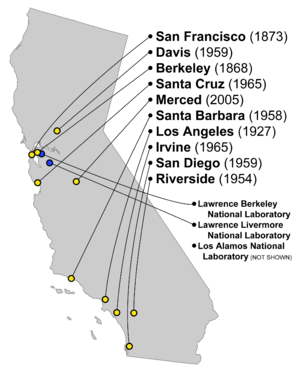
The University of California directly manages and operates two United States Department of Energy National Laboratories:
- Lawrence Berkeley National Laboratory (LBNL) (Berkeley, California)
- Lawrence Livermore National Laboratory (LLNL) (Livermore, California)
UC is a limited partner in a private company, Los Alamos National Security LLC, that manages and operates a third Department of Energy national laboratory:
Laboratory missions
Lawrence Berkeley National Laboratory conducts unclassified research across a wide range of scientific disciplines with key efforts in fundamental studies of the universe; quantitative biology; nanoscience; new energy systems and environmental solutions; and the use of integrated computing as a tool for discovery.
Lawrence Livermore National Laboratory uses advance science and technology to ensure that the US’s nuclear weapons remain safe, secure, and reliable. LLNL also has major research programs in supercomputing and predictive modeling, energy and environment, bioscience and biotechnology, basic science and applied technology, counter proliferation of weapons of mass destruction, and homeland security. It is also home to the most powerful supercomputers in the world.
Los Alamos National Laboratory focuses most of its work on ensuring the safety and reliability of the US's nuclear weapons. Other work at LANL involves research programs into preventing the spread of weapons of mass destruction and US national security, such as protection of the US homeland from terrorist attack.
The UC's ties to the three laboratories have occasionally sparked controversy and protest, because all three laboratories have been intimately linked with the development of nuclear weapons. During the World War II Manhattan Project, Lawrence Berkeley Lab developed the electromagnetic method for separation of uranium isotopes used to develop the first atomic bombs. The Los Alamos and Lawrence Livermore labs have been involved in designing the nation's nuclear weapons from inception until the shift into stockpile stewardship after the close of the Cold War.
Historically the two UC national laboratories in Berkeley and Livermore named after Ernest O. Lawrence, have had very close relationships on research projects, as well as sharing some business operations and staff. In fact, LLNL was not officially severed administratively from LBNL until the early 1970s. They also have much deeper ties to the university than the Los Alamos Lab, a fact seen in their respective original names; the University of California Berkeley Radiation Laboratory and the University of California Radiation Laboratory at Livermore. The two UC laboratories in California have a combined workforce of 12,000 UC employees and operate on federally financed budgets totaling nearly $2.5 Billion.
UC distances itself from Los Alamos National Laboratory
The University of California's ties to the labs have so far outlasted all periods of internal controversy. However, in 2003, the U.S Department of Energy for the first time opened the Los Alamos National Laboratory (LANL) contract for bidding by other vendors. UC entered into a partnership with Bechtel Corporation, BWXT, and the Washington Group International, and together they created a private company called Los Alamos National Security, LLC (LANS). The only other bidder on the LANL contract was a Lockheed-Martin Corporation created company that included among others; the University of Texas System. In December 2005, a seven-year contract to manage the laboratory was awarded to the Los Alamos National Security, LLC.
On June 1, 2006, the University of California ended its direct involvement in operating Los Alamos National Laboratory, and management control of the laboratory was taken over by Los Alamos National Security, LLC. Approximately 95% of the former 10,000 UC employees at LANL were rehired by LANS to continue working at LANL. Other than UC appointing three members to the eleven member board of directors that oversees LANS, UC now has virtually no responsibility or direct involvement in LANL. UC policies and regulations that apply to UC campuses and the two national laboratories in California (LBNL, LLNL) no longer apply to LANL, and the LANL Director no longer reports to the UC Regents or UC Office of the President.
Other national research centers
The University of California also works with the NASA Ames Research Center at Moffett Federal Airfield in California. In September 2003, a ten-year contract valued at more than $330 million was awarded to the UC to establish and operate a University Affiliated Research Center (UARC) — the largest grant ever awarded the University. UC Santa Cruz manages the UARC for the University of California, with the goal of increasing the science output, safety, and effectiveness of NASA's missions through new technologies and scientific techniques. Since 2002, the NSF-funded San Diego Supercomputer Center at UC San Diego has been managed by the University of California, taking over for the previous manager, General Atomics.
Observatories
The University of California manages two observatories as a multi-campus research unit headquartered at its Santa Cruz campus.
- Lick Observatory atop Mount Hamilton, in the Diablo Range just east of San Jose.
- Keck Observatory at the 4,145 meter (13,600 ft) summit of Mauna Kea in Hawai'i.
The Astronomy Department at the Berkeley campus manages the Hat Creek Radio Observatory in Shasta County.
Hospitals
The University of California has medical schools at Davis, Irvine, Los Angeles, Riverside, San Diego, and San Francisco. UCSF is consistently ranked in the Top 10 nationwide, UCLA and UCSD in the Top 15, by U.S. News and World Report. The affiliated teaching hospitals are also highly regarded, with UCLA Medical Center ranked No. 1 on the West Coast by U.S. News and World Report.
In the latter half of the 20th century, the UC hospitals became the core of full-fledged regional health systems; they were gradually supplemented by many outpatient clinics, offices, and institutes. In 1984, San Diego County sold its public hospital to UCSD and agreed to reimburse it for treating the indigent, so that UCSD is now also responsible for San Diego's public healthcare system.
UC Extension
For over a century, the University has operated a continuing education program for working adults and professionals. At present, UC Extension enrolls over 500,000 students each year in over 17,000 courses. One of the reasons for its large size is that UC Extension is a dominant provider of Continuing Legal Education and Continuing Medical Education in California.
UC Agriculture and Natural Resources
The University of California division of Agriculture and Natural Resources plays an important role in the State's agriculture industry, as mandated by the UC's legacy as a land-grant institution. In addition to conducting agriculture research, every county in the state has a field office with county farm advisors. The county offices also support 4-H programs and have nutrition, family and consumer sciences advisors who assist local government.
UC Natural Reserve System
The NRS was established in January 1965 to provide UC faculty with large areas of land in which they could conduct long-term ecosystem research without having to worry about outside disturbances like tourists. Today, the NRS manages 35 reserves which together encompass more than 130,000 acres.
Travel and conference facilities
- UCLA operates both its own on-campus hotel, the UCLA Guest House, and a lavish conference center at Lake Arrowhead. During the summer, the conference center hosts the Bruin Woods vacation programs for UCLA alumni and their families.
- UC Berkeley's California Alumni Association operates travel excursions for alumni (and their families) under its "BearTreks" brand. BearTreks is unusual in that the tour guides are usually Berkeley professors. CAA also operates an exclusive resort in the Sierra Nevada, the Lair of the Golden Bear, also just for Cal alumni and their families.
- The University Inn and Conference Center, located in downtown Santa Cruz, is owned and operated by UC Santa Cruz.
- The UC system's Education Abroad program has two foreign campuses to support UC students: California House in London and La Casa de la Universidad de California in Mexico City. There is also a UC Washington Center in Washington, D.C.
University Airport
UC Davis operates the University Airport as a utility airport for air shuttle service in the contractual transportation of university employees and agricultural samples.
Other affiliated institutions
- University of California, Hastings College of the Law
- Kearney Research and Extension Center
Trivia
This article contains a list of miscellaneous information. (June 2007) |
- UCLA, Berkeley, and UC Santa Cruz were named by the magazine The Advocate as three of the top 20 gay-friendly campuses in the nation.[17]
- The entire UC system was considered part of the original eight Public Ivys. [4]
- UC Berkeley, UCLA, UCSD, and UC Davis were named by the magazine Washington Monthly as four of top 10 campuses in the country based on social mobility and community service.[18]
- Three UC campuses have carillon towers: UC Berkeley's Sather Tower, UC Santa Barbara's Storke Tower, and UC Riverside's Carillon Tower. Construction of a carillon tower at UC Irvine is currently underway as part of the continuing Student Center expansion on the campus.
- According to UCLA's Daily Bruin campus newspaper, UCLA is so well-known in Asia that the university has licensed its trademark to 15 UCLA-branded stores across East Asia. [5]
- Eight campuses operate on the quarter system, while Berkeley and Merced are on the semester system. However, the David Geffen School of Medicine at UCLA and all UC law schools operate on the semester system. This often leads to odd scheduling issues at Los Angeles and Davis.
- Traditionally, all UC chancellors get to live for free in a mansion on or near campus that is usually known as University House.[6] UCSD's mansion has been closed due to its age, but the university plans to replace it.
- When Anson Blake died in 1962, he gave his Kensington mansion to the University of California. In 1967, Blake House and the surrounding eleven-acre estate (Blake Garden) became the official residence of the UC President.
- Isaac Bonewits earned a Bachelor of Arts degree in Magic at the Berkeley campus in 1970 through a self-designed, inter-disciplinary independent study program. This was so controversial that the program was changed to prevent anyone from ever doing so again.
- Several characters in the television series Buffy the Vampire Slayer attend the "University of California, Sunnydale", located in the fictional city of Sunnydale, California. UC Sunnydale appears to be a composite of several UC schools: two of UC Sunnydale's dormitories are named "Kresge" and "Stevenson" (which are actual colleges on the campus of UC Santa Cruz), many of the UC Sunnydale external scenes were actually filmed at UCLA, and "Sunnydale" itself is located in the approximate geographic position of Santa Barbara. Additionally, in the television show Angel (a spin-off of Buffy the Vampire Slayer), the character Eve refers to UC Santa Cruz as her alma mater.
- Of the ten UC campuses, only three play football: UC Berkeley (also known as Cal) (Pac-10), UCLA (Pac-10), and UC Davis (Great West Football Conference).
See also
- California Community Colleges
- California State University
- Colleges and universities
- University of California Washington Center
- University of California Students Association - The officially recognized student voice of the UC system
- California Master Plan for Higher Education
- Innovative Vector Control Consortium
- University of California Natural Reserve System
- University of California Police Department
External links
- Official Website
- Office of the President
- University of California Office of Laboratory Management (official website)
- Charter
- UC Observatories
- University of California Students Association
- UC Nuclear Free
- Los Alamos National Security, LLC (Official website)
History
- Stadtman, Verne A. The University of California 1868-1968, New York: McGraw-Hill Book Co., 1970.
- Stadtman, Verne A. A Centennial Publication of the University of California, New York: McGraw-Hill Book Co., 1970.
References
- ^ Annual Endowment Report 2005. University of California Office of the President. Accessed August 11, 2006.
- ^ http://chronicle.com/premium/stats/endowments/endowment_results.php3?Year=2007&Order=1&State_Type=All_states&limit=
- ^ http://budget.ucop.edu/pres/200506/2005-06novregmtg.pdf
- ^ University of California, Office of the President, Press Release, September 28, 2005.[1]
- ^ See the list of UC campuses on the official UC systemwide site: http://www.universityofcalifornia.edu/campuses/welcome.html.
- ^ California Education Code Section 92203.
- ^ http://www.universityofcalifornia.edu/annualreport/2006/UC%20Financial%20Report%202006.pdf
- ^ http://www.ucop.edu/ucophome/uwnews/stat/statsum/fall2006/statsumm2006.pdf
- ^ http://www.universityofcalifornia.edu/annualreport/2006/UC%20Financial%20Report%202006.pdf
- ^ http://colleges.usnews.rankingsandreviews.com/usnews/edu/college/rankings/brief/t1natudoc_brief.php
- ^ http://ed.sjtu.edu.cn/ranking.htm
- ^ Tanya Schevitz, "UC Berkeley's lack of services leaves many undergrads to sink or swim: 'Little fish in a big pond,' " San Francisco Chronicle, 6 May 2001, A1.[2]
- ^ Diane Curtis, "UC Charged With Research Before Teaching," L.A. Daily News, 13 May 1990, N4.
- ^ Renee Koury, "Cal Trying To Lighten Up," San Jose Mercury News, 18 August 1990, 1B.
- ^ http://www.universityofcalifornia.edu/admissions/undergrad_adm/paths_to_adm/freshman/local_eligibility.html
- ^ http://www.universityofcalifornia.edu/admissions/undergrad_adm/selecting/camp_profiles.html
- ^ http://www.advocate.com/currentstory1_w.asp?id=35308
- ^ http://www.washingtonmonthly.com/features/2006/0609.national.html

